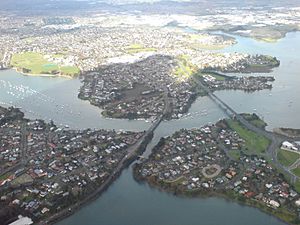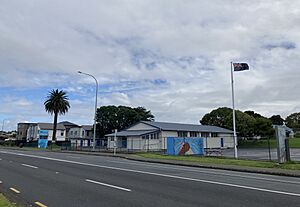Panmure, New Zealand facts for kids
Quick facts for kids
Panmure
|
|
|---|---|
|
Suburb
|
|

View of Panmure (left foreground)
|
|
| Country | New Zealand |
| Local authority | Auckland |
| Electoral ward | Maungakiekie-Tāmaki ward |
| Local board | Maungakiekie-Tāmaki Local Board |
| Board subdivision | Tamaki |
| Established | 1848 (European) |
| Area | |
| • Land | 166 ha (410 acre) |
| Population
(June 2023)
|
|
| • Total | 4,060 |
| Train station(s) | Panmure Train Station |
|
|
||
Panmure is a lively suburb in eastern Auckland, located on the North Island of New Zealand. It's about 11 kilometres southeast of Auckland CBD, which is the city centre. Panmure sits near the Tāmaki River and the northern side of the Panmure Basin. To its north is the suburb of Tāmaki, and to the west, you can see the cone of Maungarei / Mount Wellington.
Contents
Understanding Panmure's Population
This section helps us understand the people who live in Panmure. Panmure covers an area of about 1.66 square kilometres. As of 2023, it has an estimated population of around 3,651 people. This means there are about 2,200 people living in each square kilometre.
Panmure is divided into two main parts:
- Panmure West is mostly for businesses and factories.
- Panmure East is where most people live in homes.
The population of Panmure has been growing steadily. In 2006, there were 2,919 people, which grew to 3,651 by 2018. This shows that more and more people are choosing to live here.
Who Lives in Panmure?
In 2018, there were slightly more males than females. About 16% of the people were under 15 years old, and 24% were aged 15 to 29. Most people (45%) were between 30 and 64 years old.
Panmure is a very diverse place! People from many different backgrounds live here:
- About 41.6% are of European background.
- 14.1% are Māori.
- 20.7% are Pacific peoples.
- 35.0% are Asian.
- A small percentage are from other ethnic groups.
Many people identify with more than one ethnicity, showing how mixed and interesting the community is. Almost half of the people in Panmure were born outside New Zealand, which is much higher than the national average.
When it comes to beliefs, about 35.5% of people said they had no religion. Many people (44%) are Christian, while others follow Hinduism, Islam, Buddhism, or other religions.
Panmure's Rich History
Panmure has a long and fascinating history, stretching back to Māori times and continuing through European settlement.
Māori History and Important Waterways
The Māori name for the area from Panmure south-west towards the Manukau Harbour was Tauoma. This area was very important because it had two traditional portages (Te Tō Waka and Karetu). A portage is a place where people could carry their waka (canoes) overland between two different bodies of water. Here, Māori could move their canoes from the Tāmaki River to the Manukau Harbour, which was a vital travel route.
In the 1700s, land along the Tāmaki River was given as a special gift, called a tuku, by Te Tahuri of the Ngāti Whātua Ōrākei tribe to the Ngāti Pāoa tribe. A leader from Ngāti Pāoa built a fortified village called Mauināina pā on a headland. Nearby was a large unfortified village called Mokoia.
Later, a conflict broke out between Ngāti Whātua and Ngāti Pāoa. By 1820, thousands of people lived along the Tāmaki River at Mokoia.
The Musket Wars and Their Impact
In 1821, during the Musket Wars, a large group of warriors from the Ngāpuhi tribe, led by Hongi Hika, attacked Mokoia and Mauināina pā. Many Ngāti Whātua warriors were away at the time. The defenders fought bravely, using stakes to slow the attackers and throwing stones. Even though the attackers had muskets, the defenders hid behind earthen walls. The attackers then built a platform to shoot into the pā.
This battle was very tough and had a huge impact. Mokoia and Mauināina pā were destroyed. The land became tapu (sacred or forbidden) for Ngāti Pāoa because so many people had died there, and it was not settled again.
European Settlement and Growth
In 1841, the government bought land in the area. In 1848, about 80 families, known as Fencibles, arrived from Ireland and England. These Fencibles were retired soldiers who were given land in return for agreeing to defend the settlement if needed. They built simple huts and called the area Maggotty Hollow.
Panmure was once considered as a possible new capital for New Zealand, but William Hobson chose Auckland instead.
Panmure's Role in Defence and Transport
The Fencibles in Panmure were called to arms only once, in 1851, when Māori warriors came to attack Auckland. The Panmure Fencibles were given ammunition to protect the Tāmaki River.
Panmure became an important town and port because of its location near the narrowest part of the isthmus. During the New Zealand Wars in the 1860s, it was a very busy place. In 1865, the Panmure Bridge opened, connecting Auckland to the farmlands and the Fencible settlement at Howick. Even after the railway reached Auckland in 1908, Panmure remained a transport hub. Steamers travelling to the goldfields in the Coromandel and Firth of Thames would stop here.
For a long time, Panmure was a small, quiet village with farms, a church, a post office, and a few shops. It was the smallest borough in Auckland. In 1955, Panmure Township joined with Mount Wellington Borough. After World War II, Panmure started to grow quickly as more suburbs developed around it, and better bridges were built to Pakuranga. This led to Panmure becoming an important commercial centre.
Modern Panmure: Improving Connections
Panmure has seen many recent changes to improve transport and community life.
Better Transport with AMETI
The AMETI (Auckland-Manukau Eastern Transport Initiative) project has made big improvements in Panmure. This project aims to connect eastern Auckland better with the south-east. As part of this, the Panmure railway station was greatly improved. This means more trains can run, and it now takes only about 17 minutes to get to Britomart station in the city centre. New roads, cycle paths, and footpaths were also built.
The Eastern Busway Project
The next stage of AMETI will complete the 7-kilometre Eastern Busway. This special bus lane will link Panmure railway station with Pakuranga and Botany. This will make public transport much faster and help reduce traffic jams. The busway is expected to carry 5.5 million passengers each year! The Panmure Roundabout will also be changed into a regular intersection, which will encourage new developments near the train station.
Tamaki Transformation Programme
In 2012, the Tamaki Transformation Programme was announced. This is a big plan to improve the community in eastern Auckland. It's the first urban regeneration programme of its kind in New Zealand. Panmure was chosen because it has a lot of potential, being close to Auckland and Manukau city centres, with a young population, green spaces, and a coastal location.
The Auckland Council and the New Zealand government created the Tamaki Redevelopment Company to make these changes happen. Their goal is to create a "thriving, attractive, sustainable and self-reliant community." Over the next 25 years, there will be many projects to improve the economy, social life, public spaces, and housing. The population in this area is expected to double, and the aim is to improve the overall quality of life for everyone living in Tamaki.
Education in Panmure
Panmure has several schools for young people:
- Panmure Bridge School is a full primary school, teaching students from years 1 to 8.
- Panmure District School is also a full primary school, teaching students from years 1 to 8.
- St Patrick's School is a state-integrated Catholic full primary school, teaching students from years 1 to 8.
- Atea College is a private Christian school that teaches students from year 1 all the way through to year 13.
All these schools welcome both boys and girls.
Notable Buildings
- St Matthias' Church (Anglican)



